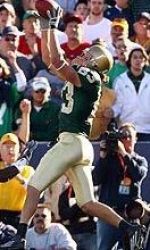
 Those of you who follow college football and/or may have watched Notre Dame at all last season may recall the tall, lanky and athletic receiver with a unique last name and long hair protruding from the back of his helmet. Baseball America's John Manuel reported this week that Jeff Samardzija, a fifth-round pick two weeks ago by the Chicago Cubs, agreed in principle with the Cubs on a contract that will allow the righthanded pitcher to continue his all-America football career at Notre Dame this fall while pursuing a career in professional baseball ("Cubs agree to deal with Notre Dame two-way star"). It is reported that Samardzija would receive a $7.25 million bonus if he makes baseball his primary sport, and the deal is backloaded with Samardzija receiving less than $1 million in the first year of the deal.
Those of you who follow college football and/or may have watched Notre Dame at all last season may recall the tall, lanky and athletic receiver with a unique last name and long hair protruding from the back of his helmet. Baseball America's John Manuel reported this week that Jeff Samardzija, a fifth-round pick two weeks ago by the Chicago Cubs, agreed in principle with the Cubs on a contract that will allow the righthanded pitcher to continue his all-America football career at Notre Dame this fall while pursuing a career in professional baseball ("Cubs agree to deal with Notre Dame two-way star"). It is reported that Samardzija would receive a $7.25 million bonus if he makes baseball his primary sport, and the deal is backloaded with Samardzija receiving less than $1 million in the first year of the deal.MLB rules permit teams to spread out payment of the signing bonus over 5 years with respect to two-sport athletes (otherwise, the bonus must be paid in full by the end of the calendar year of the year following the year in which the player was drafted -- i.e. within 1.5 years).
The contract allows Samardzija to keep his options open in football, as he is also projected to be a high NFL draft pick next year. But if and when he decides to focus exclusively on baseball, he is guaranteed $7.25 million -- which would be the largest signing bonus ever given to an amateur player. Thus far, the highest signing bonus ever for a player that signed with the club that drafted him is $6.1 million paid by the Diamondbacks to the 2005 No. 1 overall pick Justin Upton. According to Manuel, the inconsistent quality of his breaking ball and football commitment was one question that prompted Samardzija, a consensus first-round talent, to fall into the fifth round.
While I will be the first to question the use of statistics as a scouting tool, his numbers are not at all reflective of a typical first-round talent, let alone a number one pick. In three seasons for the Irish, he was 21-6, 3.82 (including 8-2, 4.33 this past spring), and his strikeout rate was low for a pitcher with power stuff. He had 61 strikeouts in 98 innings in 2006 and 159 strikeouts (and 84 walks) in 240 career innings.
This is obviously a great deal for Samardzija, and it will be interesting to see how it will impact the contract of two of the consensus top pitchers in the draft this year who have yet to sign a contract -- No. 1 pick Luke Hochevar (Royals) and No. 6 pick Andrew Miller (Tigers). I would suspect that the Royals and Tigers, who are probably negotiating bonuses in the $4M - $5M range, are not very pleased about Samardzija's deal.



